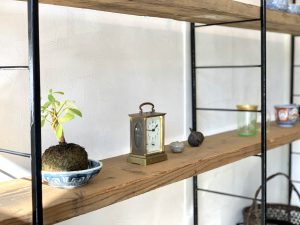九州に出かけたくなります(名古屋市千種区姫池通 古美術品買取致します。 古美術風光舎名古屋店)
2022.09.24
皆さま、こんにちは。スタッフMです。
3連休2日目名古屋市は晴れ。31度と気温も上がりじめじめした暑さですが、日陰に入ると涼しい風が吹き少しずつ過ごしやすくなってきたと思います。
昨日からの一連の大雨により、新幹線をはじめ、鉄道の運行にも影響が出ているところもあり、3連休で移動を予定されている方など心配ですが、どうか皆さま残りの休日が充実致しますように。そしてお仕事をされている方おつかれさまです。
さて、鉄道の運行といえば、2022年9月23日から長崎―武雄温泉との間を結ぶ、新しい新幹線「西九州新幹線」が開業されました。
武雄温泉・長崎間は線路延長約66kmをフル規格(標準軌)により整備し、武雄温泉駅で博多・武雄温泉間を運航する在来線特急列車と同じホームで乗り換えを行う「対面乗換方式」により運行されるそうです。
1日あたり47本運行して、博多駅~長崎駅間、最速所要時間1時間20分だそうです。早いですね~。名古屋~新大阪へ「のぞみ」に乗って向かうような、乗って休む間もなく到着というような感じですね。
そんなことはさておき、列車名は「かもめ」、最新型車両「N700S」が導入予定で、長崎発着の特急「かもめ」はなくなり、新幹線「かもめ」に移り変わります。
車両デザインは「九州らしいオンリーワンの車両」をコンセプトに、”西九州から吹く暖かくて優しい風を世界に届ける”という思いが込められているのだとか。
インテリアデザインも和洋折衷、クラシックとモダンが組み合わされた懐かしくて新しい空間が表現されているそうです。内装や外装にもこだわった「かもめ」の歴史を少し調べてみますと…
客車列車としては、昭和12年7月1日に、特急「富士」、「櫻」、「燕」に続き、「鴎」が登場いたしました。東京-神戸間で運転されていましたが、戦時体制となった昭和18年に一旦廃止されましたが、昭和28年3月には復活しました。活躍の場を東海道本線から山陽本線に移し、京都~博多間で活躍していました。
昭和36年10月、後に「サン・ロク・トオ」と呼ばれる全国白紙時刻改正が実施され、「かもめ」は当時最新鋭のキハ80系82形を使用した気動車特急に生まれ変わりました。当初は京都~長崎・宮崎間(京都~小倉間併結)を運転し、その後運転区間の変更はあったものの、関西と九州を結ぶ主要な特急のひとつに変わりはありませんでした。
昭和50年3月に、山陽新幹線博多開業に伴い気動車特急「かもめ」が廃止となりましたが、485系電車を使用したエル特急「かもめ」として再度復活。
博多~長崎間を結ぶ特急として定着すると、国鉄分割民営化後は、JR九州の看板列車の一つとして発展、平成になると赤色の車体にリニューアルされ、様々な愛称が付けられました。
赤色のかもめ以外に、「白いかもめ」の愛称で親しまれている、白を基調とした外装に振子式走行装置を装備した885系電車、また「かもめ」として一緒に運転しているのがDXグリーン席を連結した787系電車です。
戦前の特急「鴎」から引き継がれた特急「かもめ」は、各時代を代表する特急列車のひとつとして今もなお活躍し続けているのですね。
10月から新型コロナの水際対策もさらに緩和されるようですし、まだまだ油断は禁物ですが、早く西九州新幹線体験してみたいです。
では。

Hello everyone. This is staff M.
2nd day of 3 consecutive holidays, Nagoya city is sunny. The temperature has risen to 31 degrees, and it’s hot and humid, but I think it’s getting easier to spend time in the shade as the cool breeze blows.
Due to the series of heavy rains that started yesterday, the operation of the Shinkansen and other railways has been affected in some places. like. And thank you to those who are working.
By the way, speaking of railway operation, the new Shinkansen “West Kyushu Shinkansen” has been opened from September 23, 2022, connecting Nagasaki and Takeo Onsen. The line between Takeo Onsen and Nagasaki is about 66km long and has a full standard gauge. At Takeo Onsen Station, passengers transfer at the same platform as the conventional limited express trains that operate between Hakata and Takeo Onsen. It is said to be operated by It operates 47 trains per day, and the fastest travel time between Hakata Station and Nagasaki Station is 1 hour and 20 minutes.
The train name will be “Kamome”, and the latest train “N700S” will be introduced. The vehicle design is based on the concept of “a unique vehicle that is unique to Kyushu”, and it is said that the concept is to deliver the warm and gentle breeze that blows from western Kyushu to the world. The interior design is a mixture of Japanese and Western styles, and it seems that the nostalgic and new space is expressed by combining classic and modern. Let’s take a look at the history of “Kamome”, which is particular about interior and exterior…
As a passenger train, on July 1, 1937, following the limited express “Fuji”, “Sakura” and “Tsubame”, “Kamome” appeared. It was operated between Tokyo and Kobe, but it was temporarily abolished in 1943 when the wartime system became established, but it was revived in March 1953. – Moved the place of activity from the Tokaido Main Line to the Sanyo Main Line, and was active between Kyoto and Hakata.
In October 1961, a nationwide blank time revision later called “Sun Roku Too” was implemented, and “Kamome” was reborn as a diesel express using the state-of-the-art Kiha 80 series 82 at that time. Initially, it operated between Kyoto and Nagasaki/Miyazaki (connected between Kyoto and Kokura), and although there were changes in the operation section after that, it remained one of the major limited expresses connecting Kansai and Kyushu.
In March 1975, with the opening of Hakata on the Sanyo Shinkansen, the limited express “Kamome” was discontinued, but it was revived as the L limited express “Kamome” using the 485 series train. Established as a limited express connecting Hakata and Nagasaki, after the division and privatization of JNR, it developed as one of JR Kyushu’s signboard trains, and in the Heisei era, it was renewed with a red body and various nicknames were given. In addition to the red seagull, the 885 series train, nicknamed the “white seagull,” is equipped with a pendulum-type running device on a white-based exterior. This is a 787 series train with green seats.
The limited express “Kamome”, which was inherited from the pre-war limited express “Kamome”, continues to play an active role as one of the representative limited express trains of each era. From October, it seems that the measures against the new corona will be further relaxed, and I still have to be careful, but I would like to experience the West Kyushu Shinkansen as soon as possible.
*********************
ご実家の整理やお片付けなどをされている方のご相談などが多くございます。朝晩少し涼しい季節となってまりましたが、でくれぐれもご無理のないようになさってくださいませ。風光舎では古美術品や骨董品の他にも絵画や宝石、趣味のお品など様々なジャンルのものを買受しております。
お片付けをされていて、こういうものでもいいのかしらと迷われているものでも、どうぞお気軽にご相談下さいませ。
また風光舎は、出張買取も強化しております。ご近所はもちろん、愛知県内、岐阜県、三重県その他の県へも出張いたします。
まずは、お電話お待ちしております。
愛知県名古屋市千種区・骨董 買取
『古美術 風光舎 名古屋店』
TEL052(734)8444
10:00-17:00 OPEN
#西九州新幹線#かもめ

